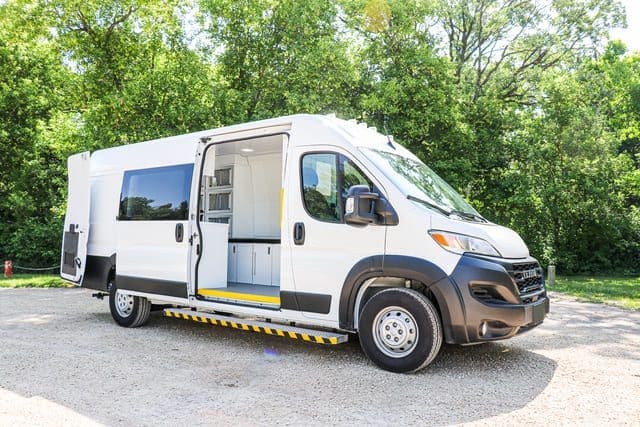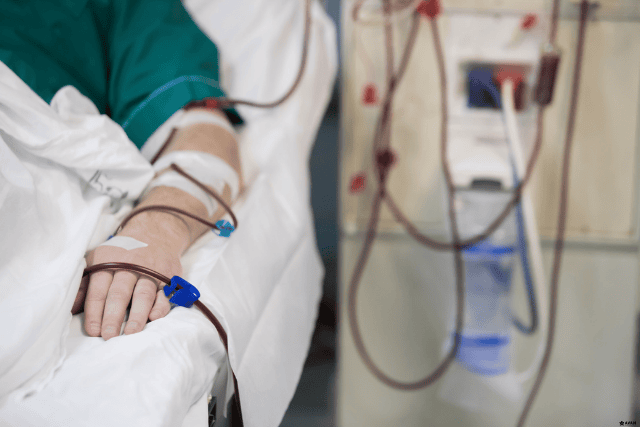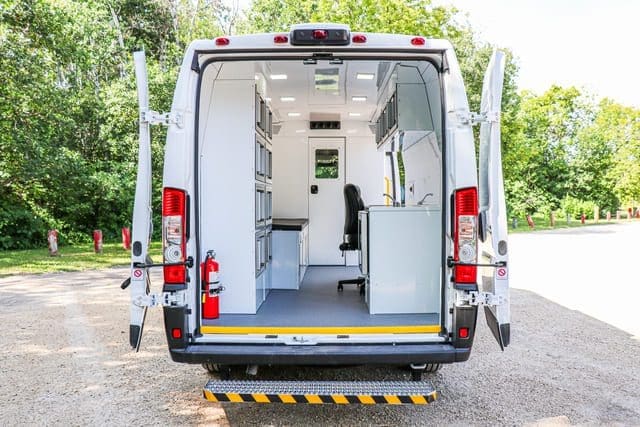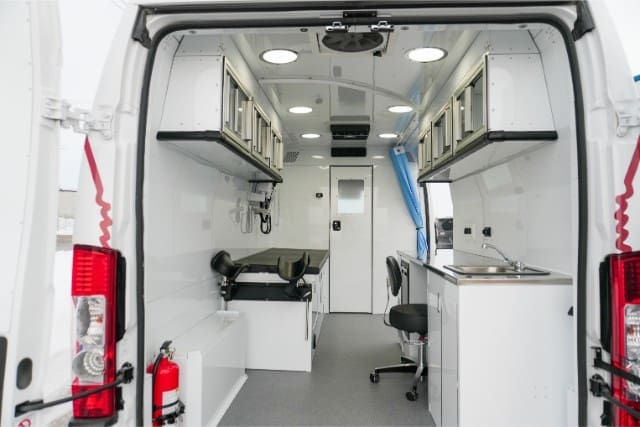Is your program or organization trying to decide between a mobile medical van vs. mobile medical bus? Some of the challenges to consider when deciding between these two vehicles are:
- Will the size of the vehicle hinder accessibility to different communities?
- Which vehicle type would be better for your program’s target population and their specific medical needs?
- What are the differences in cost between a mobile medical van vs. mobile medical bus?
At AVAN Mobility, all we manufacture are mobile medical vans for organizations that want to provide healthcare to vulnerable communities. We’ve been in the mobile medical vehicle industry for well over a decade, and have seen applications for both buses and vans. We offer four different types of mobile medical vans that can be fully customized with mobile medical van equipment to suit your program’s needs.
In this article, we’ll take a deeper look at the differences between mobile medical vans and mobile medical buses. We’ll look at what scenarios or locations are more suitable for each, as well as some key considerations to think about when deciding.
What is the purpose of a mobile medical van and a mobile medical bus?
The objectives of a mobile medical van vs. a mobile medical bus are quite similar, but they accomplish the objectives a bit differently. Let’s take a closer look.
What is a mobile medical van?

A mobile medical van is like a small clinic on wheels. It’s a vehicle that’s designed to provide healthcare services to people in different places. It can reach remote areas where it’s more difficult for people to make it to a regular hospital or clinic.
Purpose: Mobile medical vans can reach rural areas, schools, or community centers to offer medical check-ups, counseling, and basic treatments.
How does it help? The vehicle is equipped with mobile medical van equipment and supplies to help diagnose illnesses, provide simple treatments, and promote good health. It helps people stay healthy by providing medical care where they are.
What is a mobile medical bus?
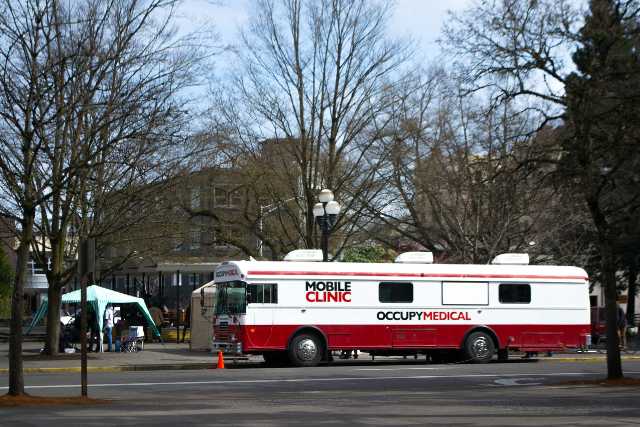
A mobile medical bus is like a bigger healthcare center on wheels. It’s a larger vehicle than a van and has more space inside.
Purpose: The main goal of a mobile medical bus is also to bring healthcare services to people in different locations, just like the van. Mobile medical buses are often used when more space is needed for medical services. An example of when a mobile medical bus would be suitable is for something like a natural disaster where nearby medical facilities have been damaged.
How does it help? The bus can travel to places where medical help is limited or not easily accessible. It offers a wider range of medical services, including more complex check-ups, tests, and treatments.
Mobile medical van vs. mobile medical bus size differences
Mobile medical vans are smaller than medical buses. They’re around 12 to 16 inches narrower and about half to a third the length of a medical bus.
How does size impact their functionality?
Due to their smaller size, mobile medical vans are easier to drive, especially in tight areas and parking lots. They can navigate through narrow streets in busy cities and fit better on tiny country roads. Another thing to note is that buses require a driver with a specialized license to operate. A mobile medical bus is classified as a bus, requiring drivers to possess a Commercial Driver’s License (CDL) to operate it legally.
It’s always best to check with your state’s licensing requirements, as they may vary depending on your region.
The size of mobile medical buses gives them more space inside for mobile medical equipment. It also gives them a little more room to provide healthcare services to patients. Since mobile medical buses are larger, they can be more challenging to drive. They need wider roads and more space to turn.
Accessibility in mobile medical vans and mobile medical buses
Both mobile medical vans and mobile medical buses can be equipped with lifts, typically located at the rear of the vehicle. These lifts are designed to assist your organization’s clients with mobility limitations, such as those who use wheelchairs or have difficulty climbing steps. The presence of these lifts ensures that everyone, regardless of their mobility level, can access the medical facilities and services offered within the vehicle.
Mobile medical vans face fewer difficulties accessing certain areas with narrow roads, rough terrain, or limited parking options compared to buses.
Limitations of mobile medical vans vs. mobile medical buses
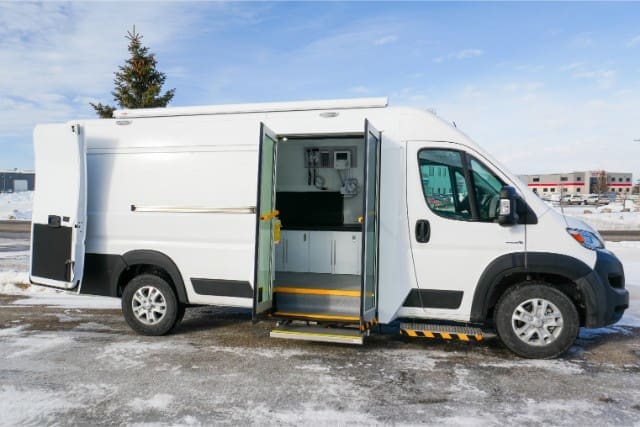
Some limitations between these two vehicles can impact what your organization uses them for.
Equipment
A mobile medical van is smaller than a mobile medical bus, so it can’t hold as much medical equipment. This means it may not have enough space for all the tools and machines needed to treat some health problems that require bigger equipment. An example of this is something like an X-ray machine or other equipment that requires more space.
Even though a van can’t fit as much equipment as a bus, it can still hold most of the essential medical equipment required by organizations.
On the other hand, a bus is bigger, allowing it to carry more medical equipment. This makes it easier to bring a wider range of medical services to clients. With that being said, a mobile medical van’s smaller size makes it easier to maintain compared to a large mobile medical bus full of complex equipment.
Weather
Both vans and buses are affected by weather conditions, such as extreme heat, cold, rain, or snow. Harsh weather can impact their ability to operate safely and can also affect the number of patients seeking healthcare services during rough weather.
Conversion times
Because of the smaller size of a mobile medical van, the conversion process is simpler and faster to build compared to a full bus conversion. Some organizations are waiting between 18 and 24 months for a large unit conversion. At AVAN Mobility, it takes us less than half the amount of time.
Capacity
Mobile medical vans have a lower occupancy capacity compared to mobile medical buses.
Vans can typically accommodate fewer patients at a time, whereas buses can hold more people due to their larger size. Depending on the needs of your program, the smaller size of a van allows for more personalized and private interactions with the patient’s care team. With fewer patients on board at once, the medical staff can give more attention to each individual.
Buses, with their higher occupancy capacity, may have a more bustling atmosphere with more patients inside the bus at the same time. While medical staff will still provide excellent care, the larger number of patients might mean slightly less one-on-one time with each person.
Cost differences between mobile medical vans vs. mobile medical buses

Mobile medical buses cost 2-3 times that of mobile medical vans. Buses are also more expensive to operate. They burn more fuel to travel the same distance as vans and require more maintenance to keep them in working condition.
Because vans use the original chassis and body that’s designed directly by the manufacturer, they require less maintenance than buses. Organizations that purchase mobile medical vans will save money on repairs over the long term.
Suitability of mobile medical vans vs. mobile medical buses
There are a variety of scenarios where choosing one vehicle might be more suitable than the other. Keep reading to learn which ones can affect your choice.
Mobile medical vans
Number of patients: If your program or organization is providing healthcare services in a remote area where there aren’t too many patients who need medical care at the same time, a van is a great choice. Your organization’s mobile medical van can provide personalized and private service instead of having a waiting list of people around the vehicle.
Rural areas and rough roads: Mobile medical vans can travel on rough roads more easily, allowing them to reach people in more remote regions. A smaller van makes it easier for your organization to take its services to these remote regions in varying weather conditions. The larger size of a mobile medical bus doesn’t make this feasible.
City convenience: In busy cities where finding parking is tricky, a van is easier to park than a big bus. It can fit into tighter spaces and bring medical care closer to where people live.
Mobile medical buses
More space, more patients: If many patients need medical help, a bus can be a better choice due to the space. It has more room to accommodate a larger number of people comfortably at the same time.
Suburban convenience: In quieter areas around the cities, where there might be more space and parking lots, a bus can be set up as an additional clinic. People can come to the bus to get the care they need.
Regulation differences between mobile medical vans vs. mobile medical buses
Mobile medical buses are heavier than mobile medical vans and fall into a higher weight class. Because of this, they need more frequent inspections and require a licensed bus driver to operate. These licenses ensure that the drivers can handle the bigger and heavier buses properly.
Mobile medical buses also face some limitations when it comes to load restrictions on some rural roads and bridges because of their heavier weight. This is because heavy mobile medical buses could damage the roads or bridges that can’t handle such weight. On average, a standard-sized mobile medical bus weighs between 20,000 to 30,000 pounds. Some bridges in rural areas in the U.S. can’t hold over 3 or 4 tons, making remote access to some places difficult.
Key considerations between mobile medical van vs. mobile medical bus
When your organization is deciding between investing in a medical van or a medical bus, there are several important factors to consider. These considerations can help you choose based on your specific needs and requirements.
Budget: The most important consideration is how much your organization can invest in the mobile medical unit. Mobile medical buses are more expensive than mobile medical vans due to their larger size and additional features.
Target population: Another factor is understanding the target population and the geographical area to be served. A mobile medical van is the better solution if your organization needs to remain low-key, operate within a city, or navigate rural roads. Vans are more maneuverable and can access tight spaces that might be challenging for larger buses.
On the other hand, if the program aims to serve a larger community or requires a spacious setup for patients, a medical bus may be the preferred choice.
Equipment and services: The type of medical equipment needed for your program is also an important consideration. A medical bus might be the best option if your program requires extremely large, specialized equipment.
If your program’s medical services don’t require extensive equipment, a mobile medical van could be a more practical and cost-effective choice.
Flexibility and future expansion: Your organization should also think about its future plans and expansion possibilities. If there is a likelihood of your program growing over time, a medical bus may offer more room for expansion and accommodate additional services or staff.
In contrast, a medical van may be a better fit for smaller, focused programs that prioritize mobility and agility over extensive space.
What’s next?
You came to this article trying to learn the differences between mobile medical vans and mobile medical buses.
You learned that the main difference between mobile medical vans and mobile medical buses is the space inside each vehicle. Mobile medical vans are more suitable for smaller-scale mobile healthcare programs that cater to remote and difficult-to-navigate areas.
Our mobile medical vans at AVAN Mobility can be fully customized depending on your program’s needs and requirements. If you’re still interested in learning more about mobile medical van options, talk to an expert today.
Alternatively, take a read through some of our other articles on the subject.
